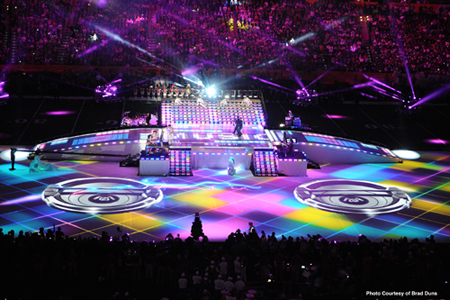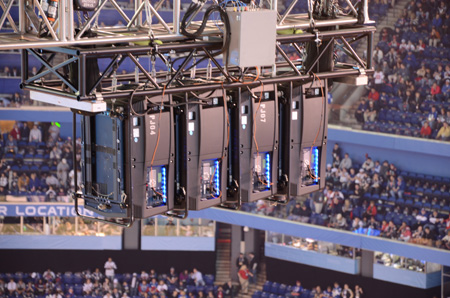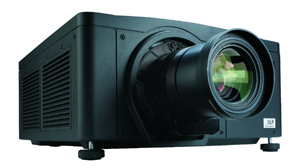The Big Guns Keep on Coming

Evolution, or Revolution in Large Venue Projection and Switching?
By Alan C. Brawn
- Product Focus: Barco RLM Series
Barco has just added a new member to its RLM family of very silent 3-chip DLP projectors. Similar to its smaller W6 and W8 cousins, the new RLM-W12 offers WUXGA resolution (1920x1200) combined with low operating cost and power consumption. Thanks to its standard 3D capa- bilities, low noise level, and 11,500 lumens light output, the RLM-W12 is a perfect fit for conference auditoriums, lec- ture halls, infotainment applications, and event venues.
“By adding a brighter unit to our RLM projector family, we can now cover the entire spectrum of silent projec- tors for fixed installations, ranging from 6000 to 11,500 lumens light output,” says Alexis Skatchkoff, product manager at Barco. “In this way, we are better able to meet customer demands for more brightness out of compact projector systems.”
As the RLM-W12 comes with standard active 3D capa- bilities, easy play-out of 3D content is guaranteed. What’s more, the RLM-W12’s TLD lenses are fully compatible with Barco’s range of HDX and FLM projectors. The new RLM-W12 is highly suitable for fixed installation in audito- riums and lecture halls, and, thanks to its optional ceiling mount and rigging stack, it can also be used for events.
As the title suggests, the question at hand is whether we are in a continuing evolutionary period in the realm of large venue projection or in actuality more of a revolutionary period. Risking the ire of the projection community, I will throw my hat in the ring that it is an evolutionary period with couple of caveats to be noted later. As with any debate we should be able to argue both sides in a convincing manner but ultimately pick our “favorite” side. In this case for me, the word revolutionary should be reserved for developments that are an order of magnitude greater than what currently exists and I simply do not think this is the case. That having been said, there are a few developments and trends that get pretty close to the grail of revolutionary so we will cover those and see what you think relative to your own position in this debate.
Every writer has their sources and mine tend to begin with the folks at Texas Instruments and their DLP team. Mike Guillory their worldwide marketing guru has become a friend over the years and he has been a trusted source who cuts to the chase when I ask him complex questions in favor of DLP or not. Our conversation began with what has come to be known as solid state illumination. Understanding that lamp free projectors do not produce (yet) enough light output to be considered large venue, Mike noted that “this year is the “coming out party” for Solid-state illumination. There are a number of DLP customers who have announced lamp-free projectors all between the 3,000 – 4,000 lumen ranges. I know that brightness level is probably not suited as much for large venue, but it certainly has total cost of ownership and quality of image implications” Of course, Mike is right about light output but the new lamp free designs offer an expanded color gamut with no fear of color shifting as the solid stage illumination ages. I also pointed out to Mike that stacking projectors is an everyday task in the rental and staging markets and all of a sudden a 4K projector becomes an 8K display. While we seem to have reached a temporary plateau in the light output of solid state illumination projectors, do not be surprised to see this obstacle overcome in the next few months and true large venue projectors introduced.
A daily selection of the top stories for AV integrators, resellers and consultants. Sign up below.

For halftime at Super Bowl XLVI, held in February 2012 at Lucas Oil Stadium in Indianapolis, Indiana, LMG assisted by partner DWP Live, a team of Super Bowl veterans, and more than 500 volunteers, rolled out and assembled the massive stage. The 12-minute show turned the stage and a 149’ x 80’ field projection area into a dynamic, continuously transforming showcase of multi-dimensional animation. Using Barco’s FLM HD20 projectors, the producers created a large-scale projection mapping showcase displaying everything from “live” Vogue magazine covers, to animated geometrics to reverberating speakers. LMG and event production company DWP Live fulfilled the projection needs, using Barco’s FLM HD20 projectors. Thirty-two Barco FLM HD20 projectors, 16 each supplied by LMG and DWP, were rigged into eight pods of four projectors each to cover the enormous image area. The projectors were operated, converged and edge-blended using Barco’s Projector Toolset to depict a wide range of imagery.
Mike then offered another insight into the projector developments coming your way and in this case it favors the side who feel we are in a revolutionary period. “The only other thing that might be relevant is a mention about interactivity. The DLP interactive projection technology solution allows users to interact with the image on the screen WITHOUT having to touch the screen itself. Interaction can occur as far as 50 feet away from the screen. This is particularly helpful for larger screen applications such as in auditoriums in higher education in which a professor may want to interact with the projected image but can’t actually reach the screen.” Outside on the movie Minority Report this was not imaginable until very recently. Put your thinking caps on and let the creativity begin! Thanks Mike.
Next in the line of evolution is Hitachi and their new projectors. I realize that 6K lumens is the entry level of large venue but they have a couple of interesting developments that are worthy of note. Their new CP-WX8255 (5.5K lumens) and CP-X8160 (6K lumens) 3LCD projectors offer solid performance and tremendous flexibility. The projectors’ new 360-degree off-axis display capability enables the projectors to be rotated a full 360 degrees along the centerline of the lens, which is ideal for rental and staging applications. Both models provide comprehensive connection options and an optional wireless adapter lets users connect their PC to the projector via a wireless network. Both models have their lenses mounted right in the center of the projector, making it easy to align the lens with the center of the projection screen for faster setup. They feature motorized focus, zoom and lens shift, allowing adjustment of the image via the remote control as well as digital keystone (horizontal and vertical) correction. In addition to the 2X zoom lens that is supplied with both projectors, four optional additional lenses are available to accommodate a wide variety of projection distances. Both models include Hitachi’s new Status Monitoring System, which provides information about the projectors’ operational status via an LED screen on the rear panel or through the Hitachi network tools software. The Status Monitoring System displays the current condition of the projectors including error messages, alarm messages and real-time monitoring of operational and network information. A unique feature of the projectors is their DICOM® (Digital Imaging and Communications in Medicine) Simulation Mode, which is ideal for viewing grayscale medical images, such as X-rays, for training and educational purposes. Each projector model will be equipped with an ultra-long-life hybrid filter that can last up to 20,000 hours without cleaning, saving significant maintenance time.
The one constant that we can always count on in large venue is that the folks at DPI never stand still and this year is no exception. They are announcing a major capabilities update to the TITAN and LIGHTNING projector families. Both series are graduating to DP’s latest NextGen electronics platform, with features including extensive Warp & Blend capabilities, 3G-SDI input compatibility, as well as specific models with high-performance 3D functionality. The latest NextGen electronics, referred to above, include DPI’s FusionExpress™ Warp & Blend technology. FusionExpress™ enables the ability to make extensive geometric warp correction via the adjustment of an interpolated grid array of up to 16 x 16 nodes. Furthermore, up to eight warp maps can be generated, downloaded and stored within the projector’s electronics.

Using Barco’s FLM HD20 projectors, the SuperBowl halftime producers created a large-scale projection mapping showcase displaying everything from “live” Vogue magazine covers, to animated geometrics to reverberating speakers. LMG and event production company DWP Live fulfilled the projection needs, using Barco’s FLM HD20 projectors. Thirty-two Barco FLM HD20 projectors, 16 each supplied by LMG and DWP, were rigged into eight pods of four projectors each to cover the enormous image area. The projectors were operated, converged and edge-blended using Barco’s Projector Toolset to depict a wide range of imagery.
In terms of new products, DPI is launching a brand-new single chip 1080p/WUXGA DLP display for Rental/Staging. DPI’s new E-Vision 1080p-8000 and E-Vision WUXGA 8000 introduce advanced display features such as integrated image Warp & Blend, Lens Memory and advanced resolution options to the E-Vision series. Additionally, the new models deliver higher brightness capabilities, producing up to 8,000 lumens of illumination. With numerous lens options, user swappable color wheels and advanced color controls, the DLP®-driven E-Vision 1080p-8000 and WUXGA-8000 continue DPI’s legacy of creating powerful, capable and efficient displays suited to serve a diversity of applications. Sounds to me like advanced warp, blend, and 3D are the key words of the day at DPI and I can’t wait to get my hands on the new E-Vision.
Of course we could never do an article without talking about the team at Christie Digital. Not only do they lead the industry in digital cinema installations, they can always be counted on to wow us at InfoComm with their spectacular booth and take image manipulation to and entirely new level. I spoke to GeorgeTsintzouras of Christie Digital regarding what is up their sleeves. He told me that “we softly launched M series portrait capabilities at NAB and at InfoComm we will continue to push the fact that Christie has the broadest portrait capable, 3 chip DLP, product line, from 5,000lm to 35,000 lm. This is a key message for our rental and staging partners as more and more applications require the flexibility to rotate the displays, and we have the broadest line of portrait capable displays. We are also pushing the limits of brightness and efficiency with the expansion of the M series product line to now include 14,000lm models that run on 110V and are only 55lbs. The expansion also includes, Roadster (rental and staging models) and Mirage(3D) models in SX+, HD and WUXGA resolutions.” George had more to say but he told me he would have to kill me if he did. By the way, did you read the 14K lumens on 110 volts comment? Hmm perhaps some of this might be revolutionary after all.
Product Focus: DPI TITAN and LIGHTNING

Digital Projection International is announcing a major features update to the TITAN and LIGHTNING projector families. Both series are graduating to DP’s latest NextGen electronics platform, with features including extensive warp and blend capabilities and 3G-SDI input compatibility, as well as specific models with high-performance 3D functionality.
When we think of large venue most of
us think of Christie Digital, Digital Projection, or even Barco but truth be told Panasonic has been in the game for some time. I was speaking to Steve Abend of
Panasonic who has been around longer than Moses (seriously) and he told me about their newest offering, the PT-DZ21K Series. After teasing Steve about the naming of their projectors via some code that needs to be deciphered, he told me about their brand new compact, 20,000 lumen 3-chip DLP projectors. The Series includes the PT-DZ21KU with WUXGA (1,920 x 1,200) resolution and 20,000 lumens of brightness, the PT-DS20KU with SXGA+ (1,400 x 1,050) resolution and 20,000 lumens of brightness, and the PT-DW17KU with WXGA (1,366 x 768) resolution and 16,500 lumens of brightness. In addition to the high brightness and compact size, the projectors boast long lamp replacement cycles of up to 2,000 hours, 3D compatibility and installation flexibility, making the projectors ideal for large-venue applications. Steve went on to say, ”the combination of four new 465W UHM lamps and Dynamic Iris allow the projectors to deliver an extremely high contrast ratio along with high brightness to produce excellent picture quality. He also mentioned their 3D capability and said “both projectors are 3D ready and they encompasses an active shutter system in which the projector can be easily equipped with an external emitter via the 3D timing signal IN/OUT terminal. For a passive polarized 3D system, frame sequential, side by side, and top and bottom formats are supported. Together, these technologies combine to create bright and beautiful images.” He also noted that the projectors are equipped with the DICOM Simulation mode, enabling end-users to view X-ray images. The most compact 20K lumen on the market with numerous advanced features and great total cost of ownership. Not a bad hand to hold by any means.
Product Focus: Christie M Series

Christie is introducing nine new to its M Series product line – including three Mirage modes – featuring 14,000 lumens, SXGA+, HD and WUXGA resolution, full 3D upgradeability and portrait mode capability. The projectors target auditoriums, boardrooms, conference rooms, houses of worship, post-production and live event users needing high brightness 3-chip DLP technology and reliability that cuts through ambient lighting. Featuring built-in blending and warping capabilities and Christie Twist, the new M Series projectors are equipped with hot swappable mercury lamps for additional cost savings. The Christie M Series offers a variety of resolutions, internal warping and blending, and full 3D capabilities with feature Mercury-based illumination for a lower cost of ownership.
It is obvious that I am a big fan of large venue projection and the technologies that drive this segment. While the above article peeks into the inner sanctums of DLP, Hitachi, DPI, Christie Digital, and Panasonic it might not qualify as truly revolutionary, but they certainly a pushing the envelope. Where we are taking the next steps in illuminations, designing warp engines to the next level, giving us a 14K lumen projector that operates on 110 or putting 20K lumen projectors on a diet of sorts, we have plenty to look at the remainder of the year. Thanks guys for providing more reasons to invest in the latest and greatest large venue projectors!
Alan Brawn (alan@BrawnConsulting.com) is a principal of Brawn Consulting LLC an audio visual and IT consulting, educational development, and market intelligence firm with national exposure to major manufacturers, distributors, and integrators in the industry. He was formerly President of Telanetix and previously National Business Development and Product Marketing Director, Samsung Electronics. Brawn is a member of the Imaging Science Foundation and Managing Director of ISF Commercial. Alan is CTS certified and an adjunct faculty member of InfoComm, and chairs its ISO/ANSI Projected Images Task Group. He is a member of the International Commission on Display Metrology for SID and a Learning Unit provider for NSCA and instructor at CEDIA. Most recently he became Director of the Digital Signage Experts Group certifying professionals in the digital signage industry. (Visit www.dseg.org for information about the Digital Signage Certified Experts program)
